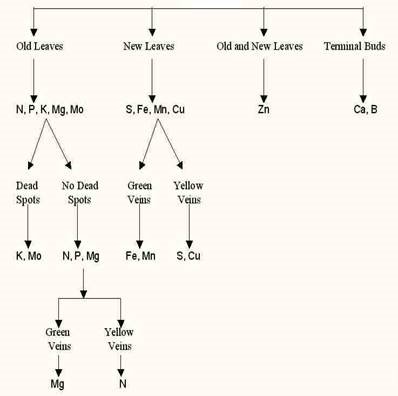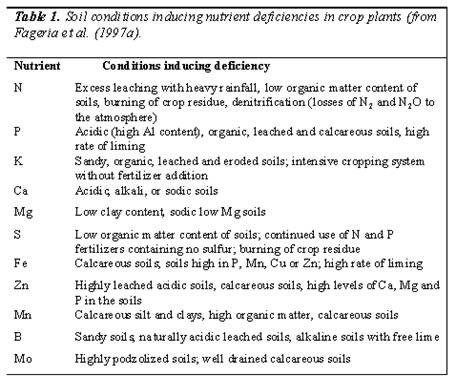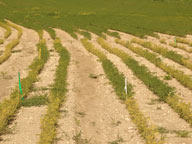Impact of Mineral Deficiency Stress
Drs Surya Kant and Uzi Kafkafi, Department of Field crops, Faculty of Agriculture , The Hebrew University PO Box 12 Rehovot, 76100, Israel
A mineral element is considered as essential, when plants cannot complete reproductive stage of life cycle due to its deficiency. Deficiency must be corrected only by supplying the element in question and when the element is directly involved in the metabolism of the plant (Arnon, 1954). Based on these criteria, sixteen elements so far were identified as essential. These are: carbon, hydrogen, oxygen, nitrogen, phosphorus, potassium, calcium, magnesium, sulfur, iron, manganese, zinc, copper, boron, molybdenum and chlorine. Most of the carbon as carbon dioxide enters the plant from the air; hydrogen and oxygen are taken up as water. The rest of the elements are taken up from the soil solution as mineral nutrients. Among these nutrients N, P, K, Ca, Mg, and S are considered major or macro-nutrients, because they are required in large quantities that range between 1 to 150 g per kg of plant dry matter. Fe, Zn, Mn, Cu, B, Mo and Cl are minor or micro-nutrients that are required at rates of 0.1 to 100 mg per kg of plant dry matter (Marschner, 1997a). Chloride is essential in micro quantities but can accumulate in the plant in large quantities when present in high concentrations in the soil solution, (Xu et al., 2000).
All the essential nutrients are required by plants in balanced proportions. Deviation from this may result in nutritional disorders. Early detecting of nutritional deficiency stress is important. Stress might extend to the entire plant with loss of yield if relief of stress is not employed. Continuous shortage of a nutrient or nutrients might cause plant death. When two or more elements are deficient simultaneously, the composite picture of symptoms may resemble no single known deficiency. Mineral deficiency symptoms are sometimes confused with other complex field events such as damage caused by insect-pest, disease, salt stress, water stress, pollution, light and temperature injury (Bennett,1993) and herbicide damage. Toxicity of Mo or Se is similar to P deficiency (Bennett, 1993), Fe deficiency in Mango is similar to Chloride toxicity (Xu et al., 2000). Therefore, it is necessary to critically observe and define these deficiency symptoms. The deficiency symptoms might be distinguished based on the plant part that shows deficiency symptoms, presence or absence of dead spots and entire leaf or interveinal chlorosis. A description of initial appearance of deficiency symptoms on leaves is given in Fig.1 and the associated text below.

to Reddy and Reddi (1997).
Generally, nutrient deficiency in the plant occurs when a nutrient is insufficient in the growth medium and/ or cannot be absorbed and assimilated by the plants due to unfavorable environmental conditions. Nutrient disorders limit crop production in all types of soil around the world. Table 1 shows soil conditions associated with nutrient deficiencies of various nutrient elements.
Visible Symptoms of Stress
- Nitrogen (N)
The characteristic deficiency symptom of nitrogen is the appearance of uniform yellowing of leaves including the veins, this being more pronounced on older leaves as expressed in rabbit-eye and blueberries (Tamada, 1989); Fescue (Razmjoo, 1997); Ailanthus triphysa (Anoop et al., 1998); chili (Balakrishnan 1999) and sugarcane (Nautiyal et al., 2000). The leaves become stiff and erect. In dicotyledonous crops the leaves detach easily under extreme deficiency condition. Cereal crops show characteristics ‘V’ shaped yellowing at the tip of lower leaves. O’Sullivan et al., (1993) observed relatively small and pale green leaves with dull appearance in sweet potato. If such condition of nitrogen stress does persist, the result is a decreased foliage growth and shoot growth. See for example: black pepper (Nybe and Nair, 1986); douglas-fir (Friend et al.,1990) and sapota (Nachegowda et al.,1992).
- Phosphorus (P)
In phosphorus deficiency, leaves remain small, erect, unusually dark green with greenish red in sweet potato (O’Sullivan et al., 1993), bluish green in chili (Balakrishnan 1999), brown in birdsfoot trefoil (Russelle and McGraw, 1986) or purplish tinge in sugar maple (Bernier and Brazeau, 1988); blueberry (Tamada,1989) and sugarcane (Nautiyal et al., 2000). The underside develops bronzy appearance. The root growth is also restricted under phosphorus stress in black pepper (Nybe and Nair, 1986). Anthocyanin pigment increases in leaves of barley (Hamy,1983) and Arabidopsis thaliana (Trull et al., 1997) under phosphorus stress,
- Potassium (K)
Under potassium stress condition, yellowing of leaves starts from the tips or margins of leaves extending towards the center of leaf base. The yellowing is interveinal and irregular in the leaves of tomato (Besford, 1978) and blueberry (Tamada, 1989). These yellow parts become necrotic (dead spots) with leaf curling in tobacco (Arnold et al., 1986); sugar maple (Bernier and Brazeau, 1988); sapota (Nachegowda et al.,1992) and sugarcane (Nautiyal et al., 2000). There is a sharp difference between green, yellow and necrotic parts.
- Calcium (Ca)
Calcium stress in plants results in chlorosis of young leaves along the veins of birdsfoot trefoil (Russelle and McGraw, 1986) and blueberry (Tamada, 1989), if deficiency persist longer, bleaching of upper half leaf followed by leaf tip curling do occur in black pepper (Nybe and Nair, 1987) and sugarcane (Nautiyal et al., 2000). The growing bud leaf becomes chlorotic white with base remaining green, the distortion of the tips of shoots i.e. dieback was observed by Edwards and Hortan, (1997) in peach seedlings. Similarly, Spehar and Galway, (1997) found brown spots on leaves, reduced expansion and premature leaf senescence under Ca stress in soybean crop. Stress during fruiting in tomato increases susceptibility to blossom end rot (Adams and El-Gizawy, 1988; Sonneveld and Voogt, 1991 and Ho et al., 1999). Calcium stress is also responsible for other disorders such as bitter pit in apple (Ford, 1979; Monge et al., 1995 and Silva and Rodriguez, 1996); leaf tip burn in cabbage (Miao et al., 1997) and lettuce; black heart of celery; cavity spot of carrots (Scaife and Clarkson 1978); vitrescence in melons (Jean-Baptist et al., 1999).
- Magnesium (Mg)
Magnesium deficiency causes yellowing, but differs from that of nitrogen. The yellowing takes place in between veins of older leaves (Makkanen, 1995) of Picea abies and veins remain green, this is followed by necrosis of tissues in birdsfoot trefoil (Russelle and McGraw, 1986), melons (Simon et al., 1986). black pepper (Nybe and Nair, 1987) and blueberry (Tamada, 1989). Mg deficiency may be induced in tomatoes by high levels of ammonium in the nutrient solution (Kafkafi et al., 1971).
- Sulfur (S)
Sulfur deficiency cause leaves to become yellowish in black pepper (Nybe and Nair, 1987); potato (Gupta and Sanderson, 1993) and Brassica oleracea (Stuiver et al., 1997) and it appears similar to nitrogen deficiency, but the symptoms are first visible on younger leaves (Russelle and McGraw, 1986). The affected leaves are narrow and the veins are paler and chlorotic than interveinal portion, especially towards the base with marginal necrosis in sugarcane (Nautiyal et al., 2000).
- Iron (Fe)
The principal veins remain conspicuously green and surrounding portion of the younger leaves turn yellow tending towards whiteness in chickpea (Mehrotra and Gupta, 1990 and Saxena et al., 1990); groundnut (Reddy et al., 1993); radish, cauliflower, cabbage and sorghum (Preeti et al., 1994); lentil (Zaiter and Ghalayini, 1994) and soybean (Fonts and Cox, 1998). Under sever deficiency, most part of the leaf becomes white (Russelle and McGraw, 1986).
- Zinc (Zn)
The leaves become narrow and small in chili (Balakrishnan, 1999), the lamina becomes chlorotic in sweet potato (O’Sullivan et al., 1993), sour orange seedlings (Swietlik, 1995) and chickpea (Khan et al., 1998), while veins remain green. Subsequently, dead spots develop all over the leaf including veins, tips and margins under sever deficiency, shoot growth is reduced (O’Sullivan et al., 1993; Swietlik, 1995 and Yu and Rengel, 1999). Khaira disease in rice results due to zinc deficiency (Gautam and Sharma, 1982; Sharma et al., 1988 and Sahi et al., 1992). Shoot elongation is reduced and a tuft or rosette of distinctly narrow leaves is produced at the shoot terminal in apple and pear. The symptoms are termed ‘little leaf’ or ‘rosette’ (Hanson, 1993).
- Boron (B)
Boron deficiency causes yellowing or chlorosis of youngest leaves and stems (Yu et al., 1998) which starts from the base to the tip. Rosetting of terminal shoots of potato (Roberts and Rhee, 1990). Leaf tip burn, elongate and become whitish brown in rice (Yu et al., 1998). Death of terminal bud occurs in extreme cases. Boron deficiency causes brown heart in radish (Shelp et al., 1987) and crown choking in coconut (Baranwal et al., 1989).
- Manganese (Mn)
The principal veins as well as smaller veins are green, the interveinal portion become chlorotic in Ailanthus triphysa (Anoop et al., 1998) followed by necrosis and browning of interveinal tissue in melons (Simon et al., 1986). The affected young leaves remain small and abscise before older leaves in birdsfoot trefoil (Russelle and McGraw, 1986).
- Molybdenum (Mo)
The common symptoms of Mo deficiency in plants include a general yellowing, marginal and interveinal chlorosis, marginal necrosis, rolling, scorching and downward curling of margins in poinsettia cultivars (Cox and Bartley, 1987; Cox, 1992) and in various field, horticulture and forage crops (Gupta and Gupta, 1997). The deficiency of molybdenum in cauliflower causes the disorder described as ‘Whiptail’ (Duval et al., 1991).
- Copper (Cu)
In copper deficiency, visible foliar symptoms appear on young leaves as chlorosis changing to necrosis (Conover et al., 1991; Del, 1994); rolling, wilting and twisting of leaves in wheat (Owuoche, 1995). The later affected leaves appear papery and twisted in rice (Nautiyal et al., 1999).
- Chlorine (Cl)
The symptoms of chlorine deficiency develop first on the older leaves. Discrete patches of pale green chlorotic tissue appear between the main vein near the tip of the leaf, downward cupping of some of the older leaves of Kiwifruit was observed by Smith et al., (1987). The leaflets of youngest leaves shrivel completely, older leaflets develop a brown necrosis which start near the tip and extend backwards particularly at the margins of red clover (Whitehead, 1985).
- Nickel (Ni)
Plant growth is reduced and older leaves turn chlorotic giving plants a nitrogen deficient phenotype, when grown on urea-based nutrient solutions not supplemented with Ni in tomato and soybean (Shimada and Ando, 1980; Krogmeier et al., 1991). Similar results were obtained in oilseed-rape, zucchini and soybean by Gerendás and Sattelmacher (1997).
Related Publications
- Principles of Plant Nutrition, by K. Mengel and E. A. Kirkby. (International Potash Institute, Berne, Switzerland).
- Diagnosis of Mineral Disorders in Plants. Vol. 1, Principles, by C. Bould, E. H. Hewitt, and P. Needham. (Chemical Publishing, New York, 1984).
- Diagnosis of Mineral Disorders in Plants. Vol. 2, Vegetables, by A. Scarfe and Mary Turner. (Chemical Publishing, New York, 1984).
- Plant Analysis Handbook, by J. Benton Jones Jr., B. Wolf, and H. A. Mills. (Micro-Macro Publishing, Athens, GA, 1991).
- Nutritional Disorders of Plants, Ed. by, Werner Bergmann. (Gustav Fischer Verlag, Gena, Germany, 1992).
- Nutrient Deficiencies and Toxicities in Crop Plants, Ed. by, William F. Bennett. (The American Phytopathological Society, St. Paul Minnesota, 1993).
- Mineral Nutrition of Higher Plants2nd Ed. by, H. Marschner (Academic Press, London, 1997).
- Growth and nutrition of field crops2nd Ed. by, N. K. Fageria; V. C. Baligar, and C. A. Jones. (Marcel Dekker, Inc. New York, 1997).
Reviews
- Raun W.R. Johnson G.V. 1999. Improving nitrogen use efficiency for cereal production Agron. J. 91:357-363.
- Liptay A. Arevalo A.E. 2000. Plant mineral accumulation, use and transport during the life cycle of plants: A review Can. J. Plant Sci. 80:29-38.
Cited Literature
Abadia, A.; Sanz, M.; Rivas, J.; Abadia, J. and De, L. 1988. Pear yellowness; an atypical form of iron chlorosis. Acta Horticulturae. 256: 177-181.
Abrol, Y. P. 1990. Pattern of nitrate assimilation and grain nitrogen yield in field-grown wheat (Triticum aestivum). In: M. L. van Beusichem (Ed.), Plant nutrition- physiology and applications, Kluwer Academic Publishers, Dordrecht. 773-778.
Adams, P. and El-Gizawy, A.M. 1988. Effect of calcium stress on the calcium status of tomatoes grown in NFT. Acta Horticulturae. 22: 15-22.
Anoop, E.V.; Gopikumar, K. and Babu, L.C. 1998. Visual symptoms and chlorophyll production of Ailanthus triphysa seedlings in response to nutrient deficiency. J. Tropical Forest Sci. 10(3): 304-311.
Arnold, N.; Chong, C. and Binns, M. 1986. Seasonal nutrient contents in grey and non-grey flue-cured tobacco. Beitrage zur Tabakforschung Int. 13(5): 265-269.
Arnon, D.J. 1954. Trace elements in plant physiology. In ‘Chronica Botanica’ (Ed. T. Wallace), Waltham, Massachusetts.
Balakrishnan, K. 1999. Studies on nutrients deficiency symptoms in chilli (Capsicum annum L.). Indian J. Plant Physiol. 4(3): 229-231.
Baranwal, V.K.; Manikandan, P.; Ray, A.K. 1989. Crown choking disorder of coconut: a case of boron deficiency. J. Plantation Crops. 17(2): 114-120.
Bar-Yosef, B. and Kafkafi, U. 1972. Rates of growth and nutrient uptake of irrigated corn as affected by N and P fertilization. Soil Sci. Soc. Am. Proc. 36: 931-936.
Bennett, W. F. 1993. Plant Nutrient Utilization and Diagnostic Plant Symptoms, In: Nutrient Deficiencies and Toxicities in Crop Plants. The American Phytopathological Society, St. Paul Minnesota, pp. 1-7.
Bernier, B. and Brazeau, M. 1988. Nutrient deficiency symptoms associated with sugar maple dieback and decline in the Quebec Appalachians. Canadian J. Forest Res. 18(6): 762-767.
Besford, R.T. 1978. Effect of sodium in the nutrient medium on the incidence of potassium deficiency symptoms in tomato plants. Plant and Soil. 50(2): 427-432.
Brown, P. H.; Nacer, B.; Hening, H. and Abhaya, D. 1999. Transgenically enhanced sorbital synthesis facilitates phloem boron transport and increase tolerance of tobacco to boron deficiency. Plant Physiol. 119: 17-20.
Cakmak, I.; Sary, N.; Marschner, H.; Kalayci, M.; Yilmaz, A.; Eker, S. and Gulut, K. Y. 1996a. Dry matter production and distribution of Zn in bread and durum wheat genotypes differing in Zn efficiency. Plant and Soil. 180: 173-181.
Cakmak, I.; Sary, N.; Marschner, H.; Ekiz, H.; Kalayc, A.; Yilmaz, A. and Braun, H. J. 1996b. Release of phytosiderophores in bread and durum wheat genotypes differing in Zn efficiency. Plant and Soil. 180: 183-189.
Cakmak, I.; Derici, R.; Torun, B. Tolay, I.; Braun, H. J. and Schlegel, R. 1997a. Role of rye chromosome in improvement of zinc efficiency in wheat and triticale. In: Plant Nutrition- for sustainable food production and environment, T. Ando et. al. (Eds), Kluwer Academic Publishers, Tokyo. 237-241.
Cakmak, I.; Ekiz, H.; Yilmaz, A.; Torun, B.; Kolele, N.; Gultekin, I.; Alkan, A. and Eker, S. 1997b. Differential response of rye, triticale, bread wheat, and durum wheat to Zn deficiency in calcareous soils. Plant and Soil. 188: 1-10.
C F A, 1985. Methods of applying fertilizer. In: Western Fertilizer Handbook (8th Eds). Interstate Publishers, Inc. Danville, USA. 161-182.
Conover, C.A.; Poole, R.T. and Satterthwaite, L.N. 1991. Soil temperature and copper rate affect growth and copper deficiency of Aglaonema commutatum ‘Fransher’. J. Environmental Hort. 9(2): 65-67.
Cox, D.A. and Bartley, G.C. 1987. Lime, molybdenum and cultivars effects on molybdenum deficiency of poinsettia. Res. Report Series Albama Agric. Expt. Station, Auburn Univ. publ.1988, No. 5, 13.
Cox, D.A. 1992. Poinsettia cultivars differs in their response to molybdenum deficiency. HortScience. 27(8): 892-893.
Dell, B.1994. Copper nutrition of Eucalyptus maculata Hook seedlings: requirements for growth, distribution of copper and the diagnosis of copper deficiency. Plant and Soil. 167(2): 181-187.
Destain, J. P.; Bodson, B.; Herman, J. L.; Francois, E. and Franc, J. 1997. Uptake and efficiency of split applications of nitrogen fertilizer in winter wheat. In: Plant Nutrition- for sustainable food production and environment, T. Ando et. al. (Eds), Kluwer Academic Publishers, Tokyo. 633-634.
Dong, B.; Rengel, Z. and Graham, R. D. 1995. Root morphology of wheat genotypes differing in Zn efficiency. J. Plant Nutr. 18: 2761-2773.
Duval, L ; More, E. and Sicot, A. 1991. Observations on molybdenum deficiency in cauliflower in Brittany. Comtes Rendus de I Academic d Agriculture de France. 78(1): 27-34.
Edwards, J.H. and Horton, B. D. 1979. Response of peach seedlings to calcium concentration in nutrients solution. J. American Soc. Hort. Sci. 104(1): 97-99.
El-Fouly, M. M. and El-Sayed, A. A. 1997. Foliar fertilization; an environmentally friendly application of fertilizers. In: Mortvedt, J. J. (Ed.) Proceedings of Dahlia Greidinger International Symposium on Fertilization and the Environment, Technian Haifa. pp.346-358.
Erenoglu, B.; Cakmak, I.; Marschner, H.; Romeheld, V.; Eker, S.; Daghan, H.; Kalaycy, M. and Ekiz, H. 1996. Phytosiderophores release does not relate well to zinc efficiency in different bread wheat genotypes. J. Plant. Nutr. 19: 1569-1580.
Fageria, N. K.; Baligar, V. C. and Jones, C. A. 1997a. Growth and nutrition of field crops 2nd Ed. Marcel Dekker, Inc. New York. p. 85.
Fageria, N. K.; Baligar, V. C. and Jones, C. A. 1997b. Growth and nutrition of field crops 2nd Ed. Marcel Dekker, Inc. New York. p. 127.
Fohse, D.; Classen, N. and Jungk, A. 1988. Phosphorus efficiency of plants. I. External and internal P requirement and P uptake efficiency of different plant species. Plant and Soil. 11: 101-109.
Fonts, R.L.F. and Cox, F.R. 1998. Zinc toxicity in soybean grown at high iron concentration in nutrient solution. J. Plant Nut. 21(8): 1723-1730.
Fords, E.M. 1979. The distribution of calcium in mature apple fruits having bitter pit disorder. J. Horticultural Sci. 54(1): 91-92.
Friend, A.L.; Eide, M.R. and Hinckley, T.M. 1990. Nitrogen stress alters root proliferation in Douglas-fir seedlings. Canadian J. Forest Res. 20(9): 1524-1529.
Gardner,W. K.; Barber, D. A. and Parbery, D. G. 1983. The acquisition of phosphorus by Lupinus albus L. III. The probable mechanism by which phosphorus movement in the soil/root interface is enhanced. Plant and Soil. 70: 107-124.
Gautam, R.C. and Sharma, K.C. 1982. Zinc deficiency (Khaira) as influenced by planting scheme and plant densities in rice. Plant and Soil. 69(2): 299-300.
Gerendás, J. and Sattelmacher, B. 1997. Significance of Ni supply for growth, urease activity and the concentrations of urea, amino acids and mineral nutrients of urea-grown plants. Plant and Soil. 190: 153-162.
Gerke, J.; Romer, W. and Jungk, A. 1994. The excretion of citric and malic acid by proteoid roots of Lupinus albus L.; effects on the soil solution concentrations of phosphate, iron and aluminium in the proteoid rhizosphere in samples of an Oxisol and a Luvisol. Bodenk. 157: 289-294.
Gerloff, G. C. 1987. Intact-plant screening for tolerance of nutrient deficiency stress. Plant and Soil. 99: 3-16.
Gill, M. A.; Ahmad, M. I. and Yaseen, M. 1997. Potassium-deficiency stress tolerance and potassium utilization efficiency in wheat genotypes. In: Plant Nutrition- for sustainable food production and environment, T. Ando et. al. (Eds), Kluwer Academic Publishers, Tokyo. 321-322.
Glass, A. D. M.; Siddiqui, M.Y. and Giles. K.I. 1981. Plant Physiol. 68: 457-459.
Graham, R. D. 1984. Breeding for nutritional characteristic in cereals. In ‘Advances in Plant Nutirtion’ (P. B. Tinker and A. Lauchli, eds.), Vol.1, pp. 57-102. Praeger, New York.
Graham, R. D.; Ascher, J. S.; Ellis, P. A. E. and Shepherd, K. W. 1987. Transfer to wheat of the copper efficiency factor carried on rye chromosome arm 5RL. Plant and Soil. 99: 107-114.
Graham, R. D.; Ascher, J. S. and Hynes, S. C. 1992. Selecting Zn efficient cereal genotypes for soils of low Zn status. Plant and Soil. 146: 241-250.
Grundon, N. J. 1980. Effectiveness of soil-dressing and foliar spray of copper sulfate in correcting copper deficiency of wheat (Triticum aestivum) in Queensland. Aus. J. Exp. Agric. Anim. Husb. 20: 717-723.
Gupta, U.C. and Gupta, U.C. 1997. Symptoms of molybdenum deficiency and toxicity in crops. Molybdenum in Agriculture. 160-170.
Gupta, U.C. and Sanderson, J.B. 1993. Effect of S, Ca and B on tissue nutrient concentration and potato yield. J. Plant Nut. 16(6): 1013-1023.
Hamy, A. 1983. Effect of phosphorus deficiency on pigments of barley leaves. Compets Rendus des Seances de l Academie d Agriculture de France. 69(12): 935-943.
Hansen, N. C.; Jolley, V. D.; Berg, W. A.; Hodges, M. E. and Krenzer, E. G. 1996. Phytosiderophore release related to susceptibility of wheat to iron deficiency. Crop Sci. 36: 1473-1476.
Hanson, E. 1993. Apples and Pears, In: Nutrient Deficiencies and Toxicities in Crop Plants. The American Phytopathological Society, St. Paul Minnesota, pp. 1-7.
Hera, C. 1996. The role of inorganic fertilizers and their management practices. In: C. Rodriguez-Barrueco (Ed.), Fertilizer and Environment, Kluwer Academic Publishers, Dordrecht, 131-149.
Hoching, P. J.; Keerhisinghe, G.; Smith, F. W. and Randall, P.J. 1997. Comparison of the ability of different crop species to access poorly-available soil phosphorus. In: Plant Nutrition- for sustainable food production and environment, T. Ando et. al. (Eds), Kluwer Academic Publishers, Tokyo. 305-308.
Ho, L.C.; Hand, D.J.; Fussell, M. and Papadopoulos, A.P. 1999. Improvement of tomato fruit quality by calcium nutrition. Acta Horticulturae. 481(2): 417-423.
Horesh, I. and Levy, Y. 1981. Response of iron deficient citrus trees to foliar iron sprays with a low surface tension surfactant. Sci. Hortic. (Amsterdam) 15: 227-233.
Jacques, D.J. ; Boerner, R.E.J. and Peterson, J.C. 1990. Effect of Ca supply and stress on uptake and translocation of Ca in two poinsettia cultivars. Envr. & Expt. Botany. 30(4): 525-531.
Jean-Baptist, I.; Morard, P.; Bernadac, A. and Papadopoulos, A.P. 1999. Effects of temporary calcium deficiency on the incidence of a nutritional disorder in melon. Acta Horticulturae. 481(1): 417-423.
Jolly, V.D. ; Brown, J.C. and Nugent, P.E. 1991. A genetically related response to iron deficiency stress in muskmelon. Plant & Soil. 130(1-2): 87-92.
Kafkafi, U., Walerstein, I. and Feigenbaum, S. 1971. Effect of potassium nitrate and ammonium nitrate on the growth, cation uptake and water requirement of tomato grown in sand soil culture. Israel J. Agric. Res. 21:13-30.
Khabaz-Saberi, H.; Robin, D.; Graham, R. D. and Rathjen, A. J. 1997. Genotypic variation for Mn efficiency in durum wheat (Triticum turgidium L. var. durum). In: Plant Nutrition- for sustainable food production and environment, T. Ando et. al. (Eds), Kluwer Academic Publishers, Tokyo. 289-290.
Khan, H.R. ; McDonald, G.K. and Rengel, Z. 1998. Assessment of the Zn status of chickpea by plant analysis. Plant & Soil. 198(1): 1-9.
Krogmeier, M. J.; McCarty, G. W.; Shogren, D. R. and Bremner, J. M. 1991. Effect of nickel deficiency in soybeans on the phytotoxicity of foliar-applied urea. Plant and Soil. 135: 283-286.
Landsberg, E.C. 1996. Hormonal regulation of iron stress response in sunflower roots: a morphological and cytological investigation. Protoplasma. 194(1-2): 69-80.
Lopez-Bucio, J.; Marinez, de la Vega O; Guevara-Garcia and Herrera-Estrella, L. 2000. Enhanced phosphorus uptake in transgenic tobacco plants that overproduce citrate. Nature Biotechnology. 18(4): 450-453.
Makkanen, S.K. 1995. Damage by drought stress and magnesium deficiency: experiments on young spruce clones. Allgemeine Forst Zeitschrift 50(5): 263-267.
Marschner, H. 1986. Mineral Nutrition of Higher Plants. Academic Press, San Diego, California, USA. p.461.
Marschner, H. 1997a. Introduction, Definition, and Classification of Mineral Nutrients. In: Mineral Nutrition of Higher Plants 2nd Ed. Academic Press, London. pp. 3-5.
Marschner, H. 1997b. Adaptation of plants to adverse chemical soil conditions. In: Mineral Nutrition of Higher Plants 2nd Ed. Academic Press, London. pp. 596-680.
Mehrotra, S.C. and Gupta, P. 1990. Screening of chickpea ( Cicer arietinum) varieties under iron deficiency stress conditions using biochemical indicators. Indian J. Agric. Sci. 60(8): 566-568.
Miao, Y.; Jiang, Y.T.; Zeng, G.H. and Cao, J.S. 1997. Changes of Ca2+ compartmentation and ultrastructure in inner leaves of chinese cabbage (Brassica compasteris sp. Pekinensis olson) during the development of calcium related physiological disorder. Acta Horticulturae Sinica. 24(2): 145-149.
Monge, E.; Val, J.; Sanz, M.; Blanco, A. and Montanes, L. 1995. Calcium as a plant nutrient. Bitter pit in apple. Annale de la Estaction Experimental de Aula Dei. 21(3): 189-201.
Mugwira, L. M. and Haque, I. 1993. Screening forage and browse legume germplasm to nutrient stress I: Tolerance of Medicago sativa L. to Al and low P in soils and nutrient solution. J. Plant Nutr. 16(1): 17-35.
Mugwira, L. M. and Haque, I. 1993. Screening forage and browse legume germplasm to nutrient stress II: Tolerance of Lablab purpureus L. to acidity and low P in two acid soils. J. Plant Nutr. 16(1): 37-50.
Nachegowda, V.; Sulladmath, U.V. ; Vijyakumar, N and Subhadrabandu, S. 1992. Visual nutrient deficiency symptoms in sapota ( Manilkara achras Forsberg). Acta Horticulturae. 321: 566-573.
Nautiyal, N. ; Chaterjee, C. and Sharma, C.P. 1999. Copper stress affects grain filling in rice. Commun. Soil Sci. & Plant Analysis. 30(11-12): 1625-1632.
Nautiyal, N. ; Dubey, B.K. and Chatterjee, C. 2000. Symptoms of nutrient deficiency (N, P, Ca, Mg and S ) in sugarcane grown in refined sand. Sugarcane Intr. March.; 12-17.
Nybe, E.V. and Nair, P.C.S. 1986. Nutrient deficiency in black pepper (Piper nigrum L.). 1. Nitrogen, phosphorus and potassium. Agri. Res. J. Kerala. 24(2): 132-150.
Nybe, E.V. and Nair, P.C.S. 1987. Nutrient deficiency in black pepper (Piper nigrum L.). 2. Calcium, magnesium and sulfur. Agri. Res. J. Kerala. 25(1): 52-65.
O’Sullivan, J.N. ;Asher, C. J. ; Blamey, F.P.C. and Edwards, D.G. 1993. Mineral nutrient disorders of root crops of the Pacific: Preliminary observations on sweet potato (Ipomoea batatas). Plant and Soil. 155/156: 263-267.
Otani, T; Ae, N. and Tanaka, H. 1996. Phosphorus uptake mechanism of crops grown in soils with low P status II. Significance of organic acids in root exudates of pigeon pea. Soil Sci. Plant Nutr. 42: 553-560.
Owuoche, J.O. ; Briggs, K.G. ; Taylor, G.J and Penney, D.C. 1995. Response of eight Canadian spring wheat ( Triticum aestivum L. ) cultivars to copper: copper content in leaves and grain. Canadian J. Plant Sci. 75(2): 405-411.
Podlask, W.; Werner, T.; Grum, M.; Schlegel, R. and Hulgenhof, E. 1990. Genetic differences in the copper efficiency of cereals. M. L. Van Beusichem (Ed.), Plant Nutrition- Physiology and Application, Kluwer Academic Publishers. pp. 297-301.
Preeti, J. ; Mehrotra, S.C. and Jain, P. 1994. A critical evaluation of some nutrient ratios as indicators of iron chlorosis in plants. New Botanist. 21(1-4): 167-168.
Rengel, Z. 1997. Root exudation and microflora populations in rhizosphere of crop genotypes differing in tolerance to micronutrient deficiency. In: Plant Nutrition- for sustainable food production and environment, T. Ando et. al. (Eds), Kluwer Academic Publishers, Tokyo. 243-248.
Randall, P. J. 1995. Genotypic differences in phosphate uptake. In: Genetic manipulation of crop plants to enhance integrated nutrient management in cropping systems. I. Phosphorus: Proceedings of an FAO/ICRISAT Expert Consultancy Workshop. Johnson et al. (Eds.). pp 31-47 International Crop Research Institute for the Semi-Arid and Tropics, Patancheru, Andhra Pradesh, India
Razmjoo, K. ; Imada, T. ; Sugiura, J. and Kanek, S. 1997. Seasonal variations in nutrient and carbohydrate levels of tall fescue cvs. in Japan. J. Plant Nut. 20(12): 1667-1679.
Reddy, K.B. ; Ashalatha, M. and Venkaiah, K. 1993. Differential response of groundnut genotypes to iron stress. J. Plant Nut. 16(3): 523-531
Reddy, K. B.; Bhaskar, P. V. and Venkaiah, K. 1997. Iron stress response in iron-efficient and iron-inefficient groundnut cultivars. In: Plant Nutrition- for sustainable food production and environment, T. Ando et. al. (Eds), Kluwer Academic Publishers, Tokyo. 255-256.
Reddy, T.Y. and Reddi, G.H.S. 1997. Mineral nutrition, manures and fertilizers. In Principles of Agronomy. pp. 204-256. Kalyani Publishers, Ludhiana, India.
Rengel, Z. 1995. Carbonic anhydrase activity in leaves of wheat genotypes differing in zinc efficiency. J. Plant Physiol. 147: 251-256.
Rengel, Z. and Graham, R. D. 1995. Wheat genotypes differ in Zn efficiency when grown in chelate-buffered nutrient solution. I. Growth. Plant and Soil. 176: 307-316.
Rengel, Z. and Graham, R. D. 1996. Uptake of zinc from chelate-buffered nutrient solutions by wheat genotypes differing in zinc efficiency. J Expt. Bot. 47: 217-226.
Roberts, S. and Rhee, J.K. 1990. Boron utilization by potato in nutrient cultures and in field plantings. Commun. Soil Sci. Plant Analysis. 21(11-12): 921-932.
Romheld, V. 1998. The soil-root interface (rhizosphere): Its relationship to nutrient availability and plant nutrition. In: International workshop on role of environmental and biological factors in acquisition of toxic and essential elements by plants. Research Institute of Pomology and Floriculture, Skierniewice. pp. 41-58.
Russelle, M.P. and McGraw, R.L. 1986. Nutrient stress in birdsfoot trefoil. Can. J. Pl. Sci. 66: 933-944.
Sabbe, W. E. and Batchelor, J. T. 1990. Yield and nitrogen concentrations in wheat (Triticum aestivum) as affected by split nitrogen application and growth stage. ). In: M. L. van Beusichem (Ed.), Plant nutrition- physiology and applications, Kluwer Academic Publishers, Dordrecht. 741-746.
Sahi, H.P.S.; Sharma, P.K. and Sachan, P.L. 1992. Check khaira disease of rice with zinc sulfate spray. Indian Farming. 41(11): 26.
Saric, M. R. 1987. Progress since the first international symposium : ‘Genetic aspects of plant mineral nutrition’. Beogard, 1982, and perspectives of future research. Plant and Soil. 99: 197-209.
Saxena, M.C. ; Mehrotra, R.S. and Singh, K.B. 1990. Iron deficiency in chickpea in the Mediterranean region and its control through resistant genotypes and nutrient application. Plant and Soil. 123(2): 251-254.
Scaife, M.A. and Clarkson, D.J. 1979. Calcium related disorders in plants – a possible explanation for the effect of weather. Plant and Soil. 50(3): 723-725.
Schenk, M. K. and Barber, S. A. 1979. Root characteristics of corn genotypes as related to phosphorus uptake. Agron. J. 71: 921-924.
Sekhon, G.S.1999. Potassium in Indian soils and crops. Procc. of the Indian National Sci. Academy. Part B, Reviews & Tracts Biological Sci. 65(3-4): 83-108.
Sharma, A.K. Singh, R.; Singh, U.S. and Singh, R. 1988. Effect of vescicular arbuscular mycorrhiza on uptake of phosphorus and zinc in rice (Oryza sativa L.). Current Sci. 57(16): 901-902.
Shelp, B.J.; Shattuck, V.I. and Proctor, J.T.A. 1987. Boron nutrition and mobility and its relation to the elemental composition of greenhouse grown root crops.2.Radish. Commun. in Soil Sci. and Plant Analysis. 18(2): 203-219.
Shimada, N. and Ando, T. 1980. Role of nickel in plant nutrition (2). Effect of nickel on the assimilation of urea by plants. Jpn. J. Soil Sci. Plant Nutr. 51: 493-496.
Silva, H. and Rodrigue, J. 1996. Physiological disorders of Pomaceae fruit induced by calcium deficiency. An integrated focus on the problem. Revista Fruticola.17(1): 5-17
Simon, J.E. ; Wilcox, G. E. ; Simini, M. ; Elamin, O.M. and Decoteau, R.D. 1986. Identification of manganese toxicity and magnesium deficiency on melons grown in low-pH soils. HortScience. 21(6): 1383-1386.
Singh, A. L. and Joshi, Y.C.1997. Prevention and correction of iron-deficiency chlorosis of groundnut in India. In: Plant Nutrition- for sustainable food production and environment, T. Ando et. al. (Eds), Kluwer Academic Publishers, Tokyo. 271-272.
Smith, G.S. ; Clark, C.J. and Holland, P.T. 1987. Chlorine requirement of kiwifruit (Actinidia deliciosa). New Phytologist. 106(1): 71-80.
Sonneveld, C. and Voogt, W. 1991. Effects of Ca-stress on blossom-end rot and Mg-deficiency in rockwool grown tomato. Acta Hort. 294: 81-88.
Spehar, C.R. and Galwey, N.W. 1997. Screning soybean (Glycine max L. Merrill) for calcium efficiency by root growth in low Ca nutrient solution. Euphytica. 94(1): 113-117.
Stuiver, C.E.E. ; Kok, L.J. ; Westerman, S. and Dekok, L.J. 1997. Sulfur deficiency in Brassica oleracea L : Development, biochemical characterisation and sulfur/nitrogen interactions. Russian J. Plant Physiol. 44(4): 505-513.
Swietlik, D. 1995. Interactions between zinc deficiency and boron toxicity on growth and mineral nutrition of sour orange seedlings. J. Plant Nut. 18(6): 1191-1207.
Tamada, T. 1989. Nutrient deficiency of rabbiteye and highbush blue barries. Acta Hort. 241: 132-138.
Trull, M.C.; Guitinan, M.J.; Lynch, J.P. and Deikman, J. 1997. The response of wild type and ABA mutant Arabidiopsis thaliana plants to phosphorus starvation. Plant cell and environment. 20(1): 85-92.
Whitehead, D.C. 1985. Chlorine deficiency in red clover grown in solution culture. J. Plant Nutr. 8(2): 193-198.
Xu, G.; Magen, H.; Tarchitzky, J. and Kafkafi, U. 2000. Advances in chloride nutrition of plants. Adv. Agron. 68: 97-150.
Yu, Q. and Rengel, Z. 1999. Micronutrient deficiency influences plant growth and activities of superoxide dismustases in narrow-leafed lupines. Ann. Bot. 83(2): 175-182.
Yu, X. ; Bell, P.F. and Yu, X.O. 1998. Nutrient deficiency symptoms and boron uptake mechanism of rice. J. Plant Nut. 21(10): 2077-2088.
Zaiter, H.Z. and Ghalayini, A. 1994. Iron deficiency in lentils in the Mediterranean regions and its control through resistant genotypes and nutrient application. J. Plant Nut. 17(6): 945-952.









